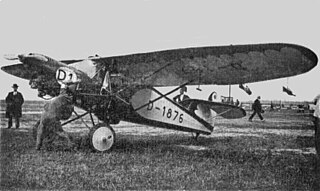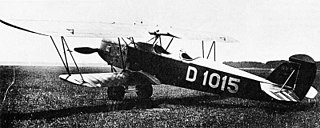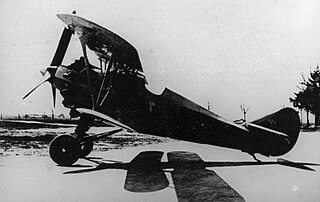
The Arado Ar 231 was a lightweight floatplane, developed during World War II in Nazi Germany as a scout plane for submarines by Arado. The need to be stored inside the submarine necessitated compromises in design that made this single-seat seaplane of little practical use.

The Arado Ar 64 was a single-seat biplane fighter designed and produced by the German aircraft manufacturer Arado. It was among the first fighters produced when Germany abandoned the restrictions of the Treaty of Versailles and began rearming.

The Arado Ar 76 was a German aircraft of the 1930s, designed as a light fighter with a secondary role as an advanced trainer in mind.
The Arado L I was a two-seat parasol-wing sport monoplane built in Germany in 1929, in order to compete in the Europa Rundflug that year. During the fuel consumption trials, the L 1 made a forced landing and was disqualified from the contest. Bringing the aircraft back to Paris, designer Hermann Hofmann performed some aerobatics over the airfield and was killed when it crashed.

The Arado L II was a 1920s German two-seat, high-wing touring monoplane.

The Arado S I was a biplane trainer built in Germany in 1925. The first of three prototypes was powered by a Bristol Lucifer radial engine, while the other two Arado S.Ia aircraft were fitted with the Siemens-Halske Sh 12. The Siemens-Halske Sh 11 powered the Arado S III, a virtually identical aircraft of which only a single prototype was constructed and sold to Turkey.

The Arado SC I was a biplane trainer developed in Germany in the 1920s. It was based on the S I, but powered by a far more powerful inline engine. Accordingly, the structure received considerable strengthening. The aircraft was intended for the clandestine military flying school at Lipetsk, but it was not accepted for this service. Instead, a small number were built for the Deutsche Verkehrsfliegerschule.
The Arado SC II was a biplane trainer designed and produced by the German aircraft manufacturer Arado.

The Arado SD II was a fighter biplane developed in Germany in the 1920s. Like the preceding SD I, it was intended to equip the clandestine air force that Germany was assembling at Lipetsk and was hoped to overcome the shortcomings of that type. Although it shared the same basic configuration, the SD II was an all-new design. A considerably larger and heavier aircraft, it had wings of less stagger, braced with conventional wires. The landing gear and tailplane were of far stronger construction.

The Arado SSD I was a biplane fighter seaplane developed in Germany in 1930, intended to be launched from catapults on warships. This was an all-new design from Walter Rethel, sharing nothing with his other fighter designs for Arado of the late 1920s. It was a conventional unequal-span, staggered biplane, with the slightly gulled top wing attached to the upper fuselage. It was equipped with a single, large float under the fuselage and two outrigger floats near the wingtips. After evaluation at Travemünde, the floats were removed and a simple, wheeled undercarriage was fitted for competitive evaluation with the Heinkel HD 38 at Lipetsk. The Heinkel was selected, and the SSD I was relegated to trainer duties with the LVS in 1932.
The Arado W 2 was a two-seat twin-engine seaplane trainer developed for the DVS in 1928. It was a cantilever monoplane with a fabric-covered steel tube fuselage that accommodated the pilot and instructor in tandem open cockpits. The undercarriage consisted of two pontoons carried on steel struts.

The Fokker D.II was a German fighter biplane of World War I. It was a single-seat fighter aircraft developed before the Fokker D.I. It was based on the M.17 prototype, with single-bay unstaggered wings and a larger fuselage and shorter span than production D.IIs. Using a 75 kW (100 hp) Oberursel U.I, the D.II was underpowered, though the single 7.92 mm (.312 in) lMG 08 machine gun was normal for 1916. The German Army purchased 177.

The Fokker D.IV was a German fighter biplane of World War I, a development of the D.I.

The Fokker D.V was a German biplane fighter of World War I.

The Fokker F.25 Promotor, first flown in 1946, was a single-engined, twin-boomed, four-seat passenger monoplane with a pusher engine mounted at the rear of a central nacelle. It was of wooden construction and has fitted with a retractable nosewheel undercarriage. One feature of the design was that instead of a 2 + 2 seating, the pilot sat in front to the left, and all three passengers were on a bench seat to the rear of him. Alternatively, when being used as an air ambulance aircraft, it could carry a patient on a stretcher, which was loaded through a hatch in the aircraft's nose. The F.25 was evocative of the pre-war G.I design.

The Fokker C.VII-W was a reconnaissance seaplane built in the Netherlands in the late 1920s. Sharing elements of the highly successful C.V design, the C.VII-W was a conventional, single-bay biplane with wings of unequal span braced with N-struts. The undercarriage consisted of a standard twin-pontoon arrangement, and the fin and rudder continued through to the ventral side of the fuselage, creating a cruciform tail. The pilot and observer sat in tandem, open cockpits. The wing structure was wooden with fabric and plywood covering, and the fuselage was of steel tube construction with fabric covering.

The Fokker D.XIII was a fighter aircraft produced in the Netherlands in the mid-1920s. It was a development of the Fokker D.XI with a new powerplant and considerably refined aerodynamics, and had been designed to meet the requirements of the clandestine flying school operated by the German Army at Lipetsk in the Soviet Union. Like its predecessor, it was a conventional single-bay sesquiplane with staggered wings braced by V-struts. The pilot sat in an open cockpit and the undercarriage was of fixed, tailskid type. The wings were made of wood and skinned with plywood, and the fuselage was built up of welded steel tube with fabric covering.

The Fokker DC.I was an aircraft produced in the Netherlands in the early 1920s to fulfill a role of combined fighter and reconnaissance aircraft. The company designation chosen by Fokker, "DC" reflected this, with "D" being the Idflieg designation for a fighter during World War I, and "C" being an armed reconnaissance aircraft. The DC.I was a conventional single-bay biplane with staggered, unequal-span wings braced by N-struts and was derived from the Fokker C.IV design. The pilot and observer sat in tandem, open cockpits, and the undercarriage was of fixed, tailskid configuration, with the main units linked by a cross-axle. The wings were of wooden construction, and the fuselage was of welded steel tube covered in fabric.
The Arado Ar 69 was a two-seat German beginner's school and sport biplane with an open cockpit, developed in 1933 by Arado Flugzeugwerke.

The Arado Ar 77 was a German twin-engined monoplane, designed as an advanced training aircraft from 1934.
















